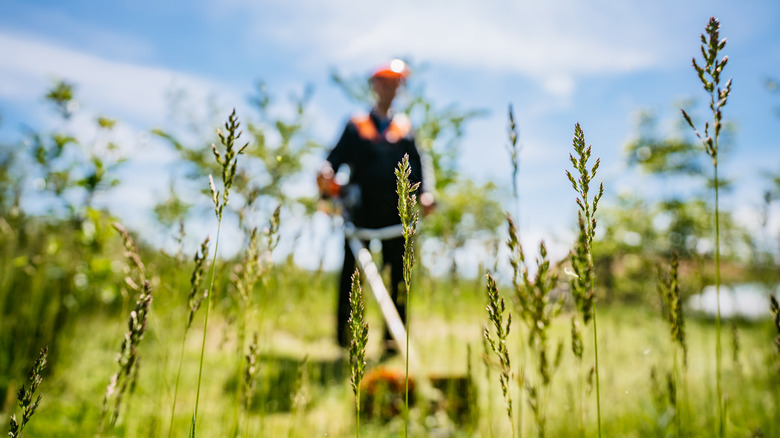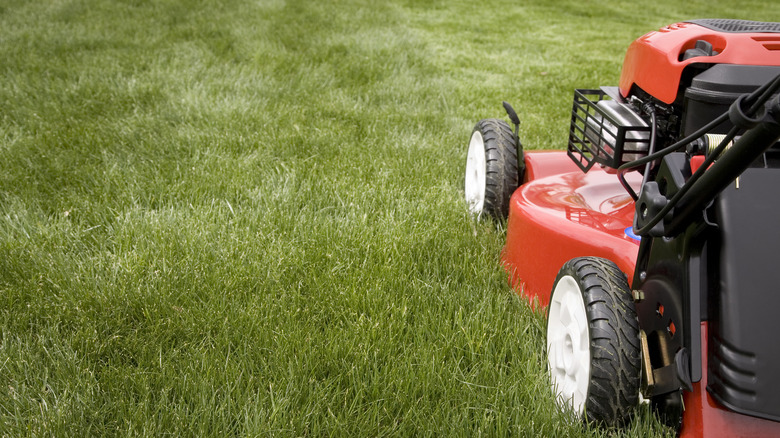This Mowing Technique Is The Most Effective Way To Control Pesky Weeds
Weeds are a persistent problem for many gardeners and homeowners. These unwanted plants compete with desirable grasses and plants for resources such as nutrients, water, and sunlight. They can quickly overrun a lawn or garden, leading to an unsightly and unhealthy environment. Weeds can be particularly problematic because they often have adaptive advantages, such as rapid growth rates and prolific seed production, which allow them to spread quickly.
Traditional methods of weed control, like chemical herbicides, can be effective but come with environmental concerns and potential health risks. Additionally, pulling weeds by hand can be labor-intensive and may not address the underlying issue of weed propagation. Understanding the life cycle of weeds is crucial in developing effective control strategies. For instance, many weeds spread through both seeds and vegetative means, making it essential to prevent them from flowering and seeding. This is where strategic mowing comes into play as an effective, environmentally-friendly method for controlling weed growth.
To effectively manage spring weeds, it's crucial to understand their lifecycle and take early action. Monitoring your lawn for early signs of weed growth is essential. By understanding the specific weeds common in your area and their growth patterns, you can tailor your lawn care strategy to be more proactive. Early intervention is key to preventing weeds from establishing a strong presence and spreading seeds. Regular mowing, along with proper lawn care practices, can significantly reduce weed infestations and help maintain a healthy, weed-free lawn throughout the growing season.
The science behind mowing for weed control
Strategic mowing, when done correctly, can be a powerful tool for controlling weeds. The science behind this technique is based on disrupting the weed's life cycle, particularly preventing them from reaching maturity and producing seeds. By mowing your lawn regularly and at the right height, you can significantly reduce the ability of weeds to reproduce and spread. The optimal mowing height for weed control is typically higher than many might expect.
The golden rule of mowing is to never remove more than one-third of the grass blade in a single mowing. Each type of grass has an optimal mowing height, such as Bermuda (1 ½" to 1 ¾"), St. Augustine (3" to 3 ½"), and Zoysia (1 ½" to 2 ¼"). Maintaining the proper height ensures your grass absorbs more sunlight, retains moisture, and shades out potential weeds. Taller grass also has a deeper root system, which can outcompete weeds for water and nutrients. Furthermore, regular mowing ensures that any existing weeds are cut down before they have a chance to flower and set seed. This consistent disruption of their reproductive cycle gradually reduces the weed population over time. Combined with good lawn care practices, such as proper fertilization and irrigation, strategic mowing can help create a dense, healthy lawn that is naturally resistant to weeds.
Implementing effective mowing practices
To implement effective mowing practices for weed control, start by setting your mower to the correct height. This helps maintain healthy grass and prevents stressing the lawn, which can create opportunities for weeds to take hold. Sharpening your mower blades regularly ensures clean cuts, which promotes healthy grass growth and reduces the risk of disease.
Mid morning or late afternoon mowing helps avoid the heat of the day, reducing stress on your grass. Varying your mowing pattern each time can also be beneficial, as it prevents soil compaction and encourages even growth. Combine your mowing strategy with other good lawn care practices. Topdressing can create the perfect conditions for a lush lawn. Proper watering, fertilization, and aeration all contribute to a robust lawn that can outcompete weeds.
How you handle grass clippings after mowing significantly impacts lawn health. Instead of bagging and removing clippings, leave them on the lawn to decompose naturally. When mowed correctly — removing only the top third of the grass blade and mowing when the lawn is dry — the clippings will disperse and break down quickly, returning valuable nutrients to the soil. This practice feeds beneficial bacteria that decompose the clippings into organic matter, enriching the lawn and reducing waste.


